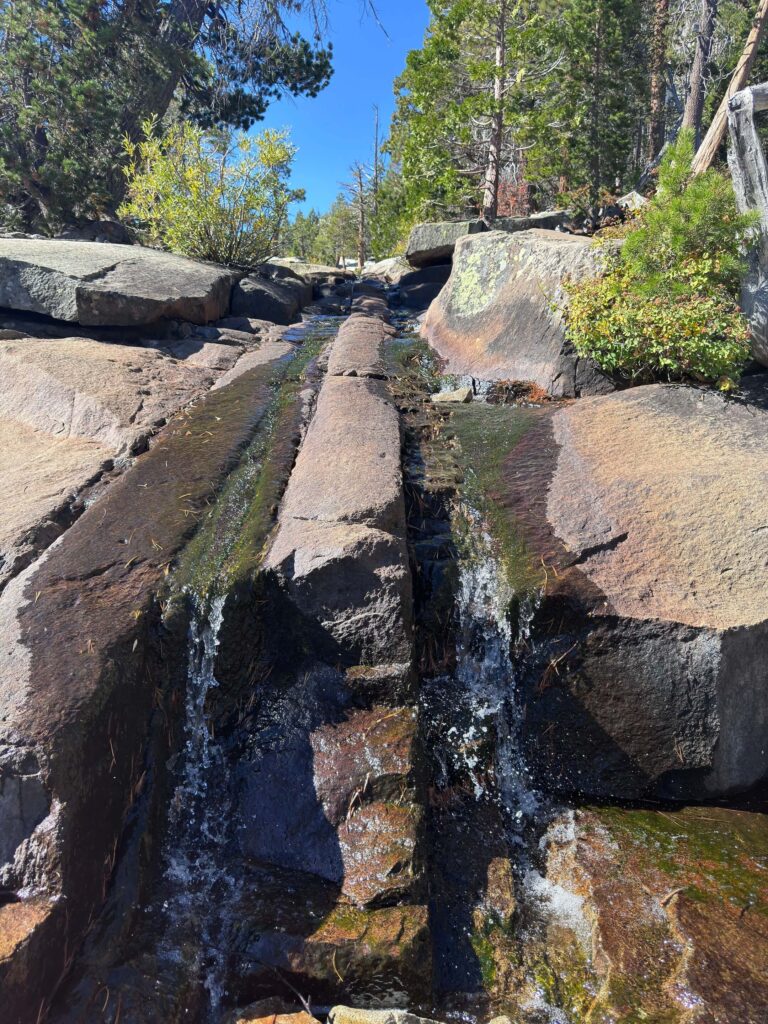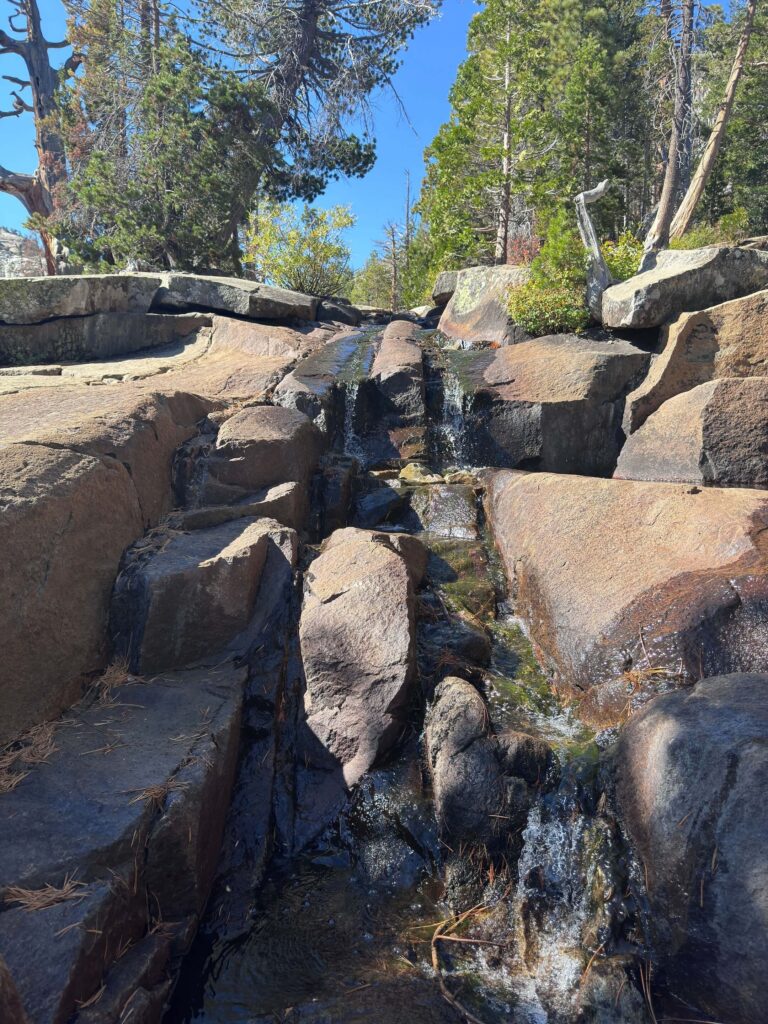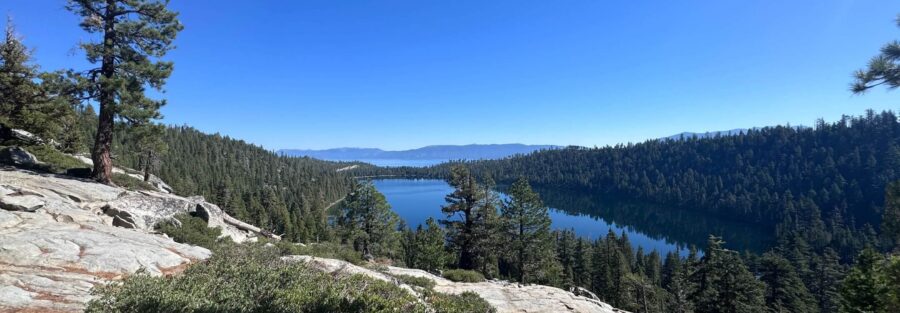Quick Facts:
Location: South Lake Tahoe, California
Coordinates: 38.94392835095658, -120.09964293954414
Length: 1.5 Miles
Difficulty: Moderate
Elevation Gain: 200’
Dog Friendly: Yes
Introduction:
Hiking the Cascade Falls Trail is one of the best ways to experience the natural beauty of Lake Tahoe’s wilderness. Located near South Lake Tahoe, this relatively short trail leads you to the stunning Cascade Falls, offering breathtaking views of Cascade Lake and Lake Tahoe along the way. It’s a perfect hike for families, casual hikers, and anyone looking to enjoy the serenity of a forested trail with spectacular water features. Whether you’re looking for an easy day hike or just want to take in some of Tahoe’s iconic scenery, the Cascade Falls Trail is a fantastic choice.
How to Get There:
The Cascade Falls Trailhead is located in the Bayview Campground, just off Highway 89, near Emerald Bay. From South Lake Tahoe, it’s about a 15 minute drive along the scenic highway. If you’re coming from the north shore, follow Highway 89 around the west side of Lake Tahoe, where the trailhead is easily accessible and clearly marked. The campground is situated directly across from Inspiration Point, a popular overlook for those driving along the highway, making it easy to spot.
Parking Information:
Parking for Cascade Falls is available at the Bayview Campground, which serves as the primary trailhead for this hike. If the campground lot is full, additional parking can sometimes be found along the shoulder of Highway 89, but be cautious of traffic.

Description of the Landscape:
The Cascade Falls Trail is relatively short but packs in some of the best natural beauty that the Lake Tahoe Basin has to offer. As you hike, the trail takes you through a forest of towering pines and fir trees, providing shade and a tranquil atmosphere. Along the way, there are stunning views of Cascade Lake, a smaller alpine lake that sits just below Lake Tahoe. The clear waters of Cascade Lake reflect the surrounding granite cliffs and tree lined ridges, creating a stunning scene that feels far removed from the hustle of daily life.
The highlight of the hike, Cascade Falls, awaits at the end of the trail. The falls cascade down over large granite boulders into a rocky canyon, especially impressive during the spring and early summer when snowmelt is at its peak. The roar of the falls combined with the panoramic views of Lake Tahoe in the background make this a truly magical spot. If you’re visiting later in the season, the falls might slow to a trickle, but the views remain breathtaking.
Trail Difficulty and Length:
The Cascade Falls Trail is considered easy to moderate, making it suitable for hikers of all skill levels. The entire hike is approximately 1.5 miles round trip, with 200 feet of elevation gain. The trail itself is mostly rocky, so wearing sturdy shoes is recommended, but the path is well marked and easy to follow. While it’s not a long or particularly strenuous hike, some sections of the trail do involve climbing over rocks, so you’ll want to be careful in those areas, especially if hiking with children. The hike is relatively short, so you can easily complete it in an hour or two, but it’s worth taking your time to enjoy the views along the way.

Can You Bring Your Dog?
Yes, the Cascade Falls Trail is dog-friendly, making it a great option if you’re hiking with your canine companion. Dogs are allowed on the trail but must be kept on a leash at all times to protect both the wildlife and other hikers. Be sure to bring enough water for your dog, as there are no easily accessible water sources along the trail. Also, it’s important to clean up after your pet to help keep the trail pristine and enjoyable for everyone.
Local Regulations:
Since the Cascade Falls Trail is part of the Lake Tahoe Basin Management Unit, there are certain regulations to keep in mind. Day use permits are not required, but visitors are expected to follow Leave No Trace principles to preserve the natural beauty of the area. Staying on designated trails is crucial to avoid damaging the surrounding ecosystem, and campfires are prohibited due to the risk of wildfires. If you’re bringing snacks or a picnic, be sure to pack out all trash, as bears and other wildlife are common in the area. Respecting these rules helps ensure the trail remains beautiful and accessible for future visitors.

Other Trails Nearby:
If you’re looking to extend your hike or explore more of the surrounding area, there are several other trails nearby worth checking out. The Bayview Trail, which starts from the same campground, offers a longer and more challenging hike, leading you into the Desolation Wilderness and toward Granite Lake and Maggie’s Peak. For those wanting an easier option, the Eagle Lake Trail, located just a short drive away, provides a moderate hike to a beautiful alpine lake surrounded by towering cliffs. Both of these trails are accessible from Highway 89 and offer a variety of hiking experiences in the same general area.
Non-Hiking Attractions Nearby:
The Cascade Falls Trail is situated in one of the most scenic areas of Lake Tahoe, so there’s plenty to do even if you’re not planning to hike. Just across the road is Inspiration Point, a famous lookout that offers panoramic views of Emerald Bay and Fannette Island, the only island in Lake Tahoe. You can also visit Vikingsholm, a historic Scandinavian-style mansion located at the bottom of Emerald Bay, accessible via a short hike down from the Emerald Bay parking area. For those looking to enjoy some water activities, Emerald Bay is a popular spot for kayaking, paddleboarding, and boating.

Accommodations: Where To Set Up Basecamp
For classic casino action with a mountain backdrop, Harrah’s Lake Tahoe is the place to be. With spacious rooms, plenty of dining options, and nightlife right on site, this resort makes it easy to keep the fun rolling from sunrise to well past midnight.
👉Book your stay at Harrah’s Lake Tahoe today and get in on the action.
If lake views and relaxation are calling your name, Hotel Azure Tahoe is the perfect choice. Located right across from the water, it offers cozy rooms, family-friendly amenities, and easy access to South Lake Tahoe’s dining and shops. It’s the kind of spot where you can slow down and soak it all in.
👉Reserve your room at Hotel Azure Tahoe now and enjoy lakeside comfort.
Modern, lively, and packed with amenities, Bally’s Lake Tahoe delivers a fun mix of casino energy and resort-style comfort. From its updated rooms and indoor pool to the spa and on-site dining, it’s a solid pick whether you’re here for gaming, a getaway, or both.
👉Click here to book your stay at Bally’s Lake Tahoe and experience it all.
Best Time to Visit Cascade Falls:
The best time to hike the Cascade Falls Trail is during the late spring through early fall. In the spring and early summer, the snowmelt feeds the falls, making them most impressive, while the wildflowers that bloom along the trail add extra beauty to the landscape. Summer brings warm, pleasant weather, making it an ideal time for hiking, though the trail can get busy during peak tourist season. Early fall is another great time to visit, as the weather cools slightly, and the crowds begin to thin out, offering a more peaceful hiking experience. Winter hiking is possible but can be difficult due to snow and ice, which may block access to the trailhead.
Support the Adventure
To make your walls less boring, check out my photography portfolio and bring a piece of the wild and my story into your home.
If you’d like to fuel future adventures, you can donate a coffee on Ko-Fi. Every cup keeps me chasing sunrises and stories.
When you shop using my affiliate links, every click helps support this blog at no extra cost to you. It’s a small way to keep Unicorn Adventure alive and kicking while I keep exploring.
Subscribe to my mailing list for future updates, new stories, and behind-the-scenes adventures.
Stay connected with me on Instagram and Facebook for more photos and daily inspiration.
Thanks for being part of the journey, Unicorn Squadron!


